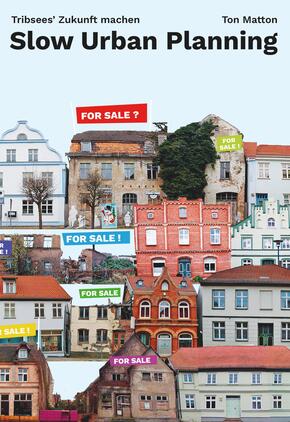Slow Urban Planning - Tribsees' Zukunft machen
| Verlag | Jovis |
| Auflage | 2023 |
| Seiten | 160 |
| Format | 17,0 x 1,1 x 23,5 cm |
| Gewicht | 448 g |
| ISBN-10 | 386859874X |
| ISBN-13 | 9783868598742 |
| Bestell-Nr | 86859874A |
Obwohl der öffentliche Raum im Osten Deutschlands nach der Wende aufwendig saniert wurde, leiden viele Kleinstädte und Dörfer unter Wegzug und Leerstand. So auch Tribsees in Mecklenburg-Vorpommern, wo zurzeit 70 von 240 Häusern in der Innenstadt unbewohnt sind. Ein Team aus Künstler_innen und Student_innen rund um Ton Matton bespielte im Jahr 2020 einige dieser Häuser, um gemeinsam mit den Bewohner_innen Möglichkeiten und Konzepte für die Zukunft ihrer Stadt auszuloten: Mit viel Improvisation und nicht immer ganz im Rahmen des Gesetzes entstanden neue Erzählungen eines städtischen Miteinanders, das auf individueller Verantwortung, (Selbst-)Versorgung und lokaler Produktion basiert.
Slow Urban Planning dokumentiert nicht nur das Projekt mit seinen künstlerischen Arbeiten, die etwa im Rahmen der Tribsees Centenniale entstanden. Es beleuchtet auch, wie stadtplanerische Prozesse gemeinhin verlaufen und wie Regelwerke angepasst werden könnten, um performative Prozesse bess er zu integrieren.
Although public spaces in the former East Germany were elaborately refurbished after reunification, many small towns and villages continue to suffer from population exodus and high vacancy rates. One of those towns is Tribsees in Mecklenburg-Vorpommern, where 70 of the 240 houses in the downtown area are currently unoccupied. In 2020, a team of artists and students led by Ton Matton engaged with a number of these buildings, sounding out possibilities and concepts for the future of the town in collaboration with residents. This resulted in new narratives of co-existence-involving large amounts of improvisation and not always in adherence to the letter of the law-based on individual responsibility, self-sufficiency, and local production.
Slow Urban Planning does more than document this project and its artistic interventions, some of which were implemented in the context of the Tribsees Centenniale. It also illuminates how urban planning processes tend to proceed in gene ral, and how regulatory structures can be adapted in order to better integrate performative processes.


















